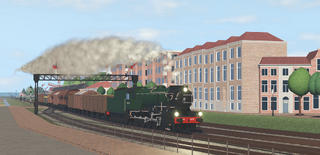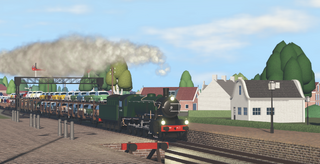| NS 5000 | |
|---|---|
| by Synchorus | |
| Price | ƒ130.000 |
| Level | 37 |
| Statistics | |
| Type | Freight |
| Top Speed | 65 km/h |
| Weight | 136 tons |
| Capacity | 520 tons |
| Length | 20,5 meters |
The NS 5000 was a class of 103 British 1'E (2-10-0) austerity locomotives used by the Nederlandsche Spoorwegen. Over a third of the 150 produced ended up under NS ownership.
Variants
The NS 5000 is available in NS Green and War Department green (only accessible with the gamepass).
Historical details
The design
Pre-war
Just before the outbreak of WWII, the Great Britain created the Ministry of Supply, which included the Directorate of Transport and Materials. The DTM was led by a head engineer of the London, Midland & Scottish Railway (LMS). The Ministry of Supply ordered 240 locomotives to help with the growing need for traction in the UK. These machines would be, minus a few unimportant details, equal to the LMS 8F, a type of locomotive that had been in service since 1935. The first one was produced by the North British Locomotive Company and delivered in late May of 1940. A total of 204 1'D locomotives were build for the War Department.
Mid-war
The designs of the 8F were too time-consuming and heavy on strategic resources to continue the production. An alternative design, using less time and resources, resulted in the Austerity 1'D, 1'E and C locomotives, some of which would later become the NS 4300, NS 5000 & NS 8800 series respectively. The 1'E locomotives were a variant of the 1'D locomotives, made for lines that only allowed locomotives with a lighter axle load.
Early 1944, these 'austerities' were shipped to Europe. At first, only the 1'D locomotives were shipped. It wasn't until the partial capitulation of Germany that the 103 produced 1'E locomotives were shipped to West-Europe. However, all three types were leased to various industries in Belgium, France, Germany and the Netherlands. Even the US army used these machines at large, albeit due to a lack of US locomotives in their sectors.
The first nine of these locomotives entered the liberated South of the Netherlands in December, 1944. Their numbers rose and dropped throughout 1945. Their most important job was the route Roosendaal - Nijmegen, on which they transported British and Canadian troops to the front lines. By October that year, they were still only found in the South of the country, where they mostly serviced the occupying British forces. They were taken out of service in the autumn of '45 and stored at various depots, including those of Roosendaal and Antwerpen in Belgium, until their fate was decided. They could not be sent back to the UK like the 1'D locomotives, because nobody in the UK gave permission. They didn't care much for these locomotives due to their extended length not allowing them to use some turntables.
The NS years
Post-war
NS was not very enthusiastic about the locomotives either. Their length meant that they also did not fit on all the turntables in the Netherlands, which limited from which depots they could be used. After the British kept insisting that a deal be made about the 60 rented locomotives Dutch Railway, one was struck in January of 1946: NS would purchase them all and put them in service as NS 5001-5060. However, around that time an acute traction shortage took place in the British occupation zone, for which the authorities there urgently requested 50 locomotives. 43 1'Es along with seven NS had bought (NS 5033/35/39-42 & 5043) were sent in response. The British provided seven 1'D locomotives to replace the temporarily unavailable 5000s. The 50 requested locomotives were no longer needed after May, so the locomotives finally got the numbers that had been reserved since January, however NS had to give back 50 NS 4300s to receive the 50 NS 5000s. With this, NS owned all austerity 1'E locomotives in Europe, with the exception of 16 in Algerian and 4 in Greece.
Some locomotives went to Belgium for maintenance between 1944-1946 and returned with their numbers painted on the smokebox door, as per Belgian customs.
In 1949, the vast majority of the class was stationed at depots in the South of the Netherlands, but Amsterdam also had one, occasionally. The 5000s were used for passenger trains much more than the NS 4300. From 1946 to 1948, they were stationed all the way up North in Groningen just to pull passenger trains. In the summer of 1948, they were the only locomotives used on the trains Zwolle - Roosendaal & Dordrecht - Venlo.

Despite this, they had relatively short service lives at NS. Despite their strength, the 4300 carried the preference. Their steel fireboxes played a big role in this (see the technical details). The first three 5000s were withdrawn as soon as 1948, with eight more in 1949 and 24 a year later. A whole 64 were sent to the scrapyard in 1951, the last of which was NS 5085 LONGMOOR.
Among the last series NS purchased was WD 73755 (NS 5085), which carried the name LONGMOOR and a memorial plate to celebrate the fact that, on May 9th, 1945, it became the 1000th locomotive Britain shipped to the mainland to assist the British troops there. Besides the LONGMOOR, three other 5000s carried names, albeit unofficial:
- At Utrecht, NS 5017 was named THE FLYING DUTCHMAN for a little while, of which the letter 'F' had disappeared rather rapidly.
- At Roosendaal, NS 5044 was named GOOD OLD RANGER for a little while.
- For all of a few hours, NS 5009 carried the name MAJOR CONSTANT MERTENS, after the liaison officer between the British Army and NS.
The NS 5000 had the nickname 'Grote Jeep' (Big Jeep), in correspondence with the shorter NS 4300, which were nicknamed 'Little Jeep'.
Post-service usefulness
The tenders of the 5000s were modified to replace the worn out 3-axle tenders of the NS 3700s, much more so than those of the 4300s. The air pumps and smokebox doors were used to replace those of the NS 3700 and the Swedish-built NS 4000 & NS 4700.
Two boilers, those of NS 5050 & 5087 were sold to the Oranje-Nassau mines medio 1950.
Post-NS

The NS 5085 LONGMOOR, after her withdrawal in 1951, was stored away and given to the Dutch railway museum in 1954. For the museum, she was restored to her WD-state, although the vacuum brake was not refitted.
Technical Details
The NS 5000 were originally equipped with the driver's place on the left, a Gresham & Craven steam-powered brake on the locomotive and tender, a Hudson riddling grate, a vacuum and air brake for the train, two Monitor-injectors, the firebox was secured with a double Ross-mechanism and sanders that only worked on the front and centre driving wheels.
When they entered service under NS, they were painted NS green without the usual black lining. They also received no number plates, unlike the Swedish and some Swiss locomotives.
The locomotives had an entirely cylindrical boiler and firebox with a wide grate. These boilers had a steam pressure of 15,8 kg/cm², but NS lowered the allowed pressure to 12 kg/cm² in 1944 to make maintenance cheaper. The Hudson grates made maintenance easier than on the 4300, at the cost of relatively narrow gaps for oxygen. This worked with fine with British coal, not so much with the Southern Limburg fuel.
The locomotives had steel fireboxes wherein the brick arch rested on three waterpipes. The firebox was also equipped with a combustion chamber, a piece of technology that would see its breakthrough in post-war Europe and was unique at NS. The combustion chamber and waterpipes were major contributors to the good steam production of these machines.
NS removed the vacuum-brake on all locomotives they bought. This brake system was only used on a few Dutch goods and tram locomotives.
The cab originally had two open windows and was open at the back. This was greatly uncomfortable for the crew when driving tender-first. This was quickly solved by NS by installing wooden backboards and little doors between the locomotive and tender. Later, the cabs were also fitted with sliding windows and roof ventilation.
The NS 5000 were similar in weight to the Baureihe 50 Ük but had only half the strength caused by a lower boiler pressure, smaller heating surfaces and a smaller cylinder diameter. For 1'E locomotives, they had the very low axle load of 13,7 tonnes which allowed them access to branchlines and even hastily laid tracks of war. The narrow branchline curves could be conquered because the front and rear driven axles could move 1,27 cm sideways. The centre three could move half that much sideways. Additionally, the tyres of the second and fourth axle had thinner flanges whilst the centre wheels did not have any flanges at all. The smallest radius the NS 5000s could drive over was 90 meters.
Trivia
- The NS 5000 was the largest steam freight locomotive, until the introduction of the BR 50 in version 0.4.10.
- The NS 5000 used to also tie with the NS 4700 for having the largest capacity for a steam locomotive, which was another title taken by the BR 50.
- The War Department gamepass is available for 300R$, and as such the WD livery is available for the same price.
- The NS 5000 has been a part of the game since version 0.1, the launch, with the NS Green and WD livery.
- In version 0.4.28 the WD livery received period correct 'War Lamps', which reduced unnecessary illumination, to reduce attention at night.
- The smoke deflectors were added in version 0.8.7.
Gallery
-
NS 5077 in the curve entering Dokmuiden
-
NS 5055 with a vehicle train speeds past Seest.





